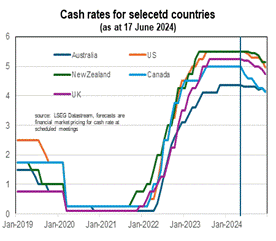
June interest rate update
Key points
- The RBA has kept the cash rate at 4.35 per cent following its June meeting.
- The RBA modestly raised its tightening bias.
- My projection is the cash rate will stay as is for the remainder of 2024.
- With both unemployment and inflation rates near 4 per cent, if there is any movement at the next 2 – 3 meetings, it would be up.
Cash rate stays at 4.35 per cent.
As widely anticipated, the RBA kept the cash rate at 4.35 per cent following its June meeting. In the accompanying statement, the RBA emphasised that inflation is not falling as fast as anticipated, and the economy is operating above capacity. The tightening bias (the risk of the next cash rate move is more likely to be up) appeared to be a little more emphatic in the June statement.
What is a tightening bias?
A tightening bias means that the RBA is leaning towards increasing interest rates in the future to help curb further inflation. It signals an intention to make it more expensive to take out a loan, making saving seem more attractive. When the RBA has a tightening bias, it shows they believe Australia's economy is strong enough to handle higher interest rates. This could be because they see prices going up too fast, the economy growing quickly, or assets like houses getting too expensive. There is flexibility in a tightening bias, meaning the RBA can change their mind if the economy starts to shift.
Short-term outlook on interest rates.
It was the higher-than-anticipated Q1 CPI that saw the RBA switch to a tightening bias. Given the June quarter CPI data will be released the week before their August decision, August could see higher interest announced. It’s clear the RBA prefers not to raise the cash rate further. The new Deputy Governor, Andrew Hauser, reiterated the same message we heard from former Governor, Philip Lowe – that the RBA has deliberately kept the cash rate lower than peer economies to minimise the rise in the unemployment rate. But with both inflation and the unemployment rate at around 4 per cent, the only way the cash rate can move over the next few meetings – is up.
Medium-term outlook on interest rates.
Looking further into the future, there are three key factors that will drive the interest rate outlook: how is the domestic economy travelling, what is happening with inflation and the outlook for global interest rates.
Peter’s prediction.
My forecast is for both GDP growth and (underlying) inflation to be below the RBA’s forecast for June quarter 2024, and so I think no rate rise is likely. The Q2 CPI figure will be the major piece of domestic economic data over the next six weeks.
Global interest rates.
The broad trend in global cash rates is down, although the decline has not been as quick as financial markets had anticipated at the beginning of this year. Interest rate cuts have taken place either where inflation is very low (Switzerland) or in economies that have a combination of falling inflation and weak economic growth (Canada, Sweden).
Therefore, the likely global monetary policy stance over the second half of this year looks to have few implications for the RBA. Apart from in Japan, the general direction of the cash rate is down globally but moves over the next few months will be modest. This means Australia’s cash rate is likely to end the year still comfortably below that of most peer economies.

The domestic cash rate is likely to be below most peer economies at year-end.
The current state of Australia’s economy.
GDP barely grew in Q1 2024, although capacity use in the economy remains high. The unemployment rate in Australia has risen by around half a percentage point, but at 4 per cent, this is still low by historical standards. Fiscal stimulus and improving real household disposable income growth means GDP growth in the second half of the year should be stronger.
But the very low household saving ratio suggests people will be saving a good portion of any additional income. Weak approvals data means residential construction activity will remain muted. And businesses are suggesting the size of their order books is slimming.
Peter’s prediction.
In summary, the current state of the economy is consistent with unchanged monetary policy. My forecast is for economic growth to pick up over the second half of this year, but not by enough to get back to ‘trend’ growth. This means a rate cut is likely to be necessary – but probably not until 2025.
But if spending in the economy is stronger than I am currently projecting (perhaps because households don’t increase their saving rate), then a more extended period of unchanged cash rate – or at worst, the possibility of another rate hike – becomes more likely.
Inflation update.
The big reason why rate hike discussion has come back on the agenda is that inflation has not fallen as quickly as expected. Inflation for the past few months has been stuck at around 3.5 – 4 per cent, about a percentage point higher than the mid-point of the RBA’s target.
The main reason for the ‘stickiness’ of inflation is that service sector inflation has remained elevated. This is where recent government announcements of subsidies to households may help. The consensus view is that giving more money to households will increase spending in the economy and make it harder for the RBA to reduce inflation.
Government subsidies would alter household spending decisions.
It is almost certain that household spending will be higher than it would have been had governments not provided the subsidies. But it is hard to know how the subsidies will interact with household spending and saving decisions. And as RBA Governor Bullock recently suggested, household financial decisions are likely to differ between extra income coming from government subsidies and those from direct cash handouts. By reducing the inflation rate this year, the subsidies could help mitigate wage claims in the following year.
An extended period of sub-trend growth should help moderate price growth. And there are increasing signs that wages growth has peaked. But if inflation keeps coming in higher than anticipated, at some stage the RBA may lose their patience.
Peter’s prediction.
The most likely next move for the cash rate is down. That is the expectation of the overwhelming number of economists, as well as current financial market pricing.
But we have not completely moved away from the possibility of a rate hike. For that to happen, the underlying inflation rate over the next couple of quarters will need to move down from its current level of around 4 per cent. That is my forecast, and why I think the cash rate has peaked. But the current inflation and unemployment rate means a rate reduction is looking like a story for 2025.
We really do live in interesting times.


